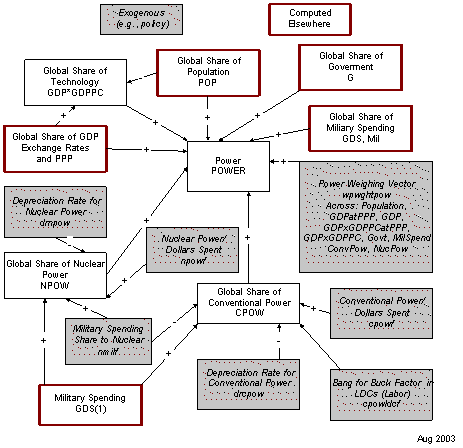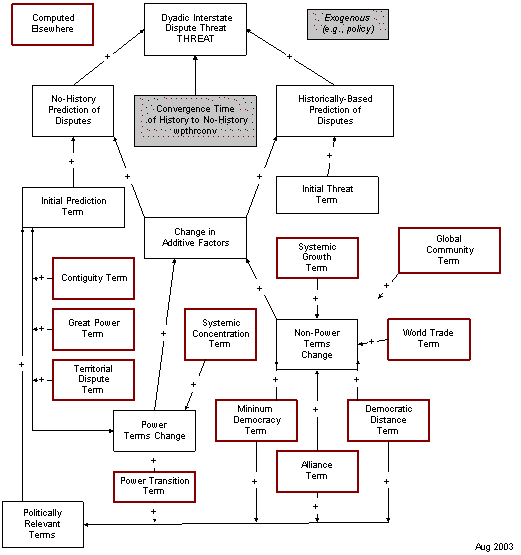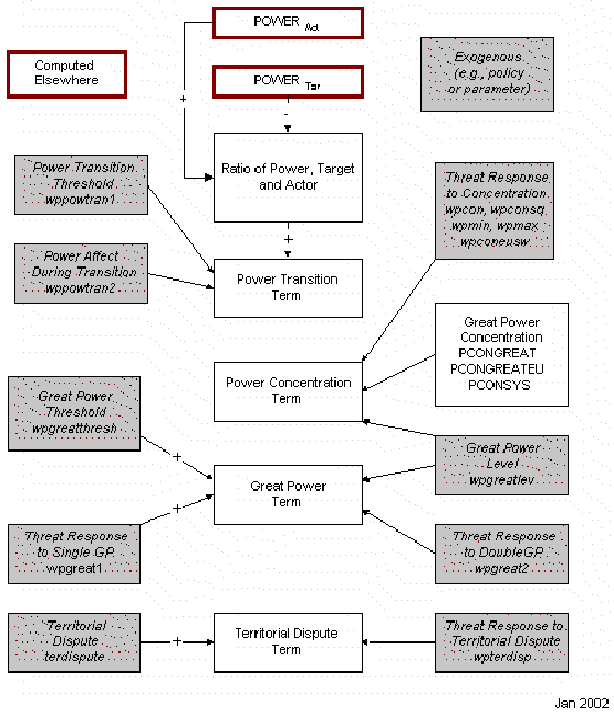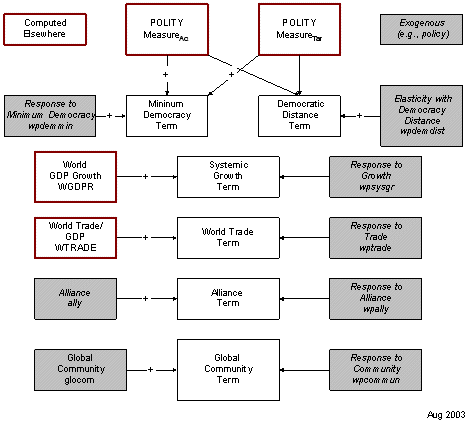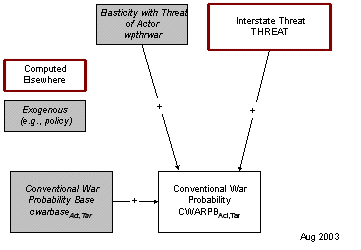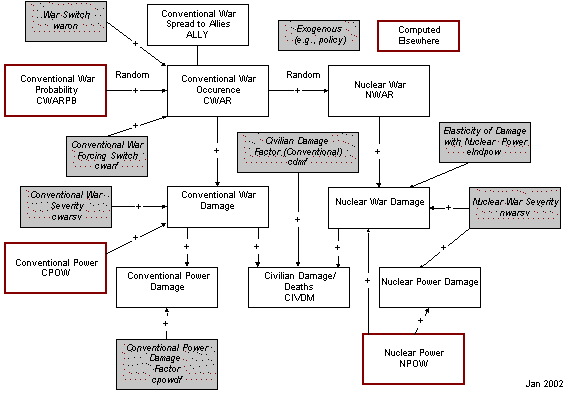Interstate Politics (IP)
The most recent and complete interstate politics model documentation is available on Pardee's website. Although the text in this interactive system is, for some IFs models, often significantly out of date, you may still find the basic description useful to you.
The interstate politics module traces changes in power balances across states and regions, allows exploration of changes in the level of interstate threat, and represents possible action-reaction processes and arms races with associated potential for conflict among countries. For more on how this data may used and analyzed within IFs, please read below.
Structure and Agent System: Interstate Interaction
System/Subsystem
|
Interstate interaction
|
Organizing Structure
|
Cooperation and conflict
|
Stocks
|
Power, threat levels
|
Flows
|
Aid flows
|
Key Aggregate Relationships (illustrative, not comprehensive)
|
Changes in power, relative power, threat, action-reaction
|
Key Agent-Class Behavior Relationships (illustrative, not comprehensive)
|
Spending on military, aid Alliances War
|
As with the domestic socio-political environment, and unlike the use of cohort-component structures in demographics and of markets and social accounting matrices for economics, there is no completely standard organizing structure that is widely used for representing interstate/international systems. Yet the representation of power-based interaction systems, including interactions related to relative power and to action-reaction dynamics, is common. IFs builds significantly on that conceptual and theoretical base.
Among the most important understandings of students of interstate/international interaction is that conflict and cooperation are not really opposites in relationships. Although the balance of conflict and cooperation will vary within and across relationships, Intensity of interaction often brings both.
Dominant Relations: Interstate Politics
Interstate Politics: Dominant Relations
Threat of states towards each other is a function of many determinants. For instance, contiguity or physical proximity creates contact and therefore the potential for both threat and peaceful interaction. Cultural similarities and differences affect threat levels. Yet certain factors are more subject to rapid change over time than are contiguity or culture. Among factors that change, the relative power of states and of their level of democratization substantially affect threat levels.
For a causal diagram see Process: Power and Process: Threat Level.
For equations see IP Equations: Power and IP Equations: Threat Formulation.
Key dynamics are directly linked to the dominant relations:
- Power is a function of population, GDP, technology, and conventional and nuclear military expenditures, in an aggregation with weights that the user can change (wpwghtpow).
- Democratization is computed in the domestic socio-political model.
Interstate Politics: Selected Added Value
The larger interstate politics model provides representation and control over a changing index of the probability of war, based on threat levels. It is possible stochastically to introduce war based on that probability and to feed back the destruction of war to population levels and economic capital.
Interstate Politics Flow Charts
Power
IFs computes a power indicator that shows each actor’s portion of global power. It does so by weighting (wpwghtpow) each actor’s share of global GDP (at exchange rates or purchasing power parity), population, a measure of technological sophistication (with GDP per capita as a proxy), government size, military spending, conventional power, and nuclear power. Weights of one "1" add the term to the power calculation, and weihts of 0 remove the term from power calculation.
Conventional and nuclear power have their own dynamics, dependent primarily on military spending. Parameters direct a share of that into nuclear power and determine the translation of spending into actual conventional power, with an assumption that Less Developed Countries can leverage spending into more power because of lower wages and other costs. Given country/regional conventional and nuclear power, it is possible to compute world conventional and nuclear power (CPOW, NPOW).
Threat Level
The threat that any state poses to another (and which may lead to conflict, war, or nothing) is affected by many factors. IFs conceptualizes of threat in concrete terms, namely the probability of what is called a militarized international dispute (MID).
IFs approaches calculation of that threat from two directions. The first is through the use of data on historic threat levels by dyad. The second is solely through the evolution of key factors that have been shown to give rise to disputes. The user can control whether the model should rely primarily upon historic patterns or primarily upon predicted ones with a convergence parameter (wpthrconv).
Regardless of the basic approach (data-based or predictive), the evolution of threat over time depends upon a variety of underlying factors. IFs groups these roughly into two categories: power and nonpower terms, explained in detail elsewhere. It should be noted, however, that three factors seem to carry special weight in determining the threat of disputes: contiguity, whether or not countries are great powers, and the existence or absence of territorial disputes between countries.
Threat Elaborated: Power Terms
One important power term that affects interstate relations depends on relative power of the countries and is especially significant when two countries of relevance to each other enter a zone of power transition. Another important term is the concentration of power among the great powers themselves. It is increasingly uncertain whether the European Union should be treated as a single actor or as a group of individual states in such power concentration calculations, so IFs allows an option.
A third factor is whether or not the two interacting states are great powers or not. It is important whether the dyad contains zero, one, or two such powers. Because the definition of great power is uncertain, IFs allows the user to specify a threshold level at which a state begins to meet that definition and a second level at which point it clearly does.
A fourth factor in the figure below is less clearly a power term. Nonetheless, existence or absence of territorial disputes between states greatly affects the probability of a militarized dispute, quite possibly more than any other single factor.
Threat Elaborated: Nonpower Terms
Among the most important factors that determine the probability of disputes between countries that are not related to their power is their level of democracy. More specifically, threat depends on the level of democracy in actor and target countries and on the difference in level, sometimes called political distance.
Studies find that trade relations between states also affect the probability of disputes between them, but results are ambiguous. Because IFs uses pooled trade, it cannot forecast the specific level of trade between any two states. The model has a term that links overall levels of global trade, as a portion of GDP, to dispute probability.
Alliances generally reduce dispute probability. Another factor that may reduce the probability is that global community is growing. This is uncertain and the linkage is not now activated.
One of the most basic factors affecting interstate relations is the closeness or contiguity of two states (small states on different continents pose little or no threat to each other).
Probability of War
The probability of conventional war depends most fundamentally on a basic conventional warfare probability per year (CWARBASE) that the user sets exogenously and that is set to zero for all country pairs (dyads) in the base case.
That probability is potentially enhanced by threat from an actor to a target country and also by the threat perceived by a target from an actor.
War
The outbreak of conventional war depends on the probability of war. The probability of war is converted into actual war randomly. The outbreak of nuclear war (only for countries with nuclear weapons) similarly depends probabilistically and randomly on the outbreak of conventional war. In order for a war to occur, the "waron" parameter must be turned on (set to 1). If it is turned on, wars may or may not occur; but a war can be forced if the waron parameter is set AND the war forcing switch (cwarf) is set to 100 or above).
We calculate damage for both conventional and nuclear power capabilities, as well as for civilian society (population and GDP).
